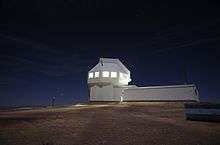Space Surveillance Telescope

Space Surveillance Telescope is a telescope for detecting and tracking orbital debris. It has a 3.5 meter (138″) aperture mirror and came online in 2011.[1][2][3]
DARPA Space Surveillance Telescope program

The Space Surveillance Telescope program (SST) is DARPA's ground based, advanced, optical system for detection and tracking of faint objects in space such as asteroids. It is also to be employed for space defense missions. The program is designed to advance, or expand, space situational awareness, and be able to quickly provide wide area search capability.
Telescope
The large curved focal surface array sensors are considered to be an innovative design. It encompasses improvements in detection sensitivity, has short focal length, wide field of view, and improvements in step-and-settle abilities. [note 1]
SST detects, tracks, and can discern small, obscure objects, in deep space with a "wide field of view system". It is a single telescope with the dual abilities. First the telescope is sensitive enough to allow for detection, also, of small, dimly lit objects (low reflectivity). Second it is capable of quickly searching the visible sky. This combination is a difficult achievement in a single telescope design.[4][5]
It is a Mersenne-Schmidt design with an F/1.0 aperture and a 3.5 meter primary mirror. It uses an array of charge-coupled device (CCD) sensors, arranged on a curved focal plane array. The SST mount uses an advanced servo-control technology, that makes it one of the quickest and most agile telescopes of its size. These features allow the system to conduct multiple searches throughout the night, including the entire geosynchronous belt within its field. As a telescope system, it can give precise locations of discovered objects, extrapolate the course of the object, and indicate the objects stability.[4][5][6]
The US Air Force ultimately took over the program and integrated the SST as a sensor in the Space Surveillance Network of the Air Force Space Command in 2009.[4][5]
Location
The SST was initially deployed for testing and evaluation at the White Sands Missile Range in New Mexico. On December 6, 2013, it was announced that the telescope system would be moved to the Naval Communication Station Harold E. Holt in Exmouth, Western Australia, as part of the Australia-U.S. Space Situational Awareness Initiative. From there it will able to observe the Southern Celestial Hemisphere and collect data for the US Space Surveillance Network. The SST system is expected to be operational in 2016.[6]
See also
- United States Space Surveillance Network
- List of largest optical reflecting telescopes
- List of largest optical telescopes in the continental United States
References
- ↑ "Space Surveillance Telescope to Provide Enhanced View of Deep Space" (Press release). DARPA. Retrieved 12 April 2011.
- ↑ "Telescope will track space junk". Nature. Retrieved 22 April 2011.
- ↑ Ackermann, Mark R.; McGraw, John T. "Large-Aperture, Three-Mirror Telescopes for Near-Earth Space Surveillance: A Look from the Outside In" (PDF).
- 1 2 3 Pike, John (2010). "Space Surveillance Telescope" (Basic overview). GlobalSecurity.org. Retrieved 2010-05-20.
- 1 2 3 Major Travis Blake, Ph.D., USAF, Program Manager (2010). "Space Surveillance Telescope (SST)" (Public Domain see Notes section). DARPA. Retrieved 2010-05-20.
- 1 2 "SST Australia: Signed, Sealed and Ready for Delivery" (Press release). DARPA. Retrieved 18 August 2014.
Notes
| Wikimedia Commons has media related to Space Surveillance Telescope. |
- ↑ DARPA Privacy and Security notice #2: Except where otherwise noted, information presented on the DARPA Web Information Service is considered public information and may be distributed or copied. Use of appropriate byline/photo/image credits is requested.